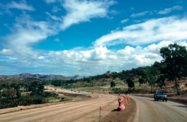With the construction phase of Papua New Guinea’s (PNG’s) liquefied natural gas (LNG) project nearing completion, the government is poised to roll out a maritime transport programme to support its bid to diversify economic interests. The far-reaching plans include overhauling ports, expanding capacity and, in some instances, relocating facilities or building new outlets to meet rising demand.
With shipping firms expecting business to remain strong throughout next year and beyond, the government is keen to push its maritime projects forward at a brisk tempo. It will also look to enlist more help from the private sector for both infrastructure development and the delivery of services across the industry.
A portfolio of new resource extraction projects awaiting government approval will take throughput demand above current capacity at a number of PNG’s mainland ports, while several facilities will also need modifying to accommodate larger cargo and passenger vessels.
Widespread acknowledgement that several facilities are outdated and unable to cope has strengthened arguments in favour of relocating key ports and rolling out greenfield developments. Container traffic has already risen 35.9% over the past five years, from 246,245 twenty-foot equivalent units (TEUs) in 2007 to 338,752 in 2012.
Revenue growth from increased traffic is enabling the government to pump funds into additional industry services and infrastructure. The first phase of a PGK41m ($19.4m) upgrade to accommodate cruise ships at Alotau has begun, while work is under way at Daru to repair loading and unloading facilities. The Wewak site is also expected to be developed further in the coming years on the back of rising demand from local industry, led by operations at the Freda copper mine.
PNG’s plans to increase capacity at its ports look set to focus in the immediate on Port Moresby (POM) and Lae, where demand is highest as a result of the LNG construction boom. Both ports, which accounted for a combined 79%, or 753,444, of all TEU movement between 2010 and end-2012, are now at their operational limit.
Demand has risen steadily at Lae, which acts as a gateway to the Highlands. The port, which is PNG’s principal commercial hub for the off-lying island provinces, was responsible for 51% of all national container traffic from 2009 to 2012. A PGK1bn ($436m) Asian Development Bank and government-backed expansion of the Lae port should help address bottlenecks when completed in 2015.
Proposals to relocate POM’s port to a new site also look to be gathering pace. A move would free up over 42,000 sq metres of prime real estate adjacent to both the central business district and Konebada, providing PNG Ports Corporation Limited (PNGPCL), the public enterprise responsible for the 23 national ports, with a substantial windfall.
Talks are currently under way between PNGPCL and Australia’s Curtain Bros (CB) on the possibility of relocating POM’s port to the 71-ha man-made Motukea Island. With established facilities capable of accommodating oversized PNG-LNG equipment, Motukea Island is an attractive option. The site already acts as a hub for ship maintenance and construction facilities, as well as accommodating PNG’s expanding Customs operations.
Significantly, CB has embarked on a 4-km quayside development that will dwarf PNG’s existing facilities. The green light has also been given for a four-lane highway to be built, which will link the facility, POM and Waigani, and ease traffic congestion. The government’s plans to complete a Trans-Island Highway by 2030 will further increase the port’s potential. The highway, which has been designated a priority by the administration, will provide an important connection from POM to Kerema, eventually also linking the hub to Lae.
Madang, however, remains the favourite site for developing additional facilities to serve the Highlands region. Current services will be put under even greater pressure when the Ramu nickel and cobalt mine begins operating, while demand will rise even higher if the Pacific Marine Industrial Zone development is given a green light. No decision has yet been made on the Madang development. However, the allocation of funding in the national budget to build a 375-km stretch of highway by 2017, linking the provincial centre of Western Highlands and Baiyer with Madang, has been interpreted as a positive sign.
Kikori, in Western Province, south of the Highlands, is currently being mooted as a third alternative. Situated within one of ten targeted economic corridors and closer to the Highlands’ principal industrial centres in Tari and Mendi than Lae, Kikori offers a number of benefits, including the potential to serve the pipeline Elk-Interoil project.
PNG’s gateway ports have played an important role in the country’s growth story. With the LNG project set to enter the next phase of its development, and national efforts to diversify the economy gaining momentum, the maritime industry is set to expand on the back of rising demand.

